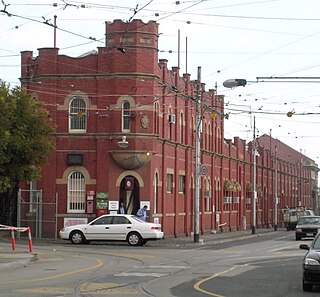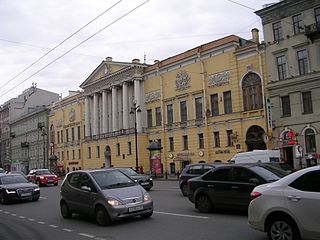
Vasilyevsky Island is an island in St. Petersburg, Russia, bordered by the Bolshaya Neva and Malaya Neva Rivers in the south and northeast, and by Neva Bay of the Gulf of Finland in the west. Vasilyevsky Island is separated from Dekabristov Island by the Smolenka River. Together they form the territory of Vasileostrovsky District, an administrative division of Saint Petersburg.

The Sydney Tramway Museum is Australia's oldest tramway museum and the largest in the southern hemisphere. It is located at Loftus in the southern suburbs of Sydney.

The NSW Rail Museum is the main railway museum in New South Wales, Australia. A division of Transport Heritage NSW, it was previously known as the New South Wales Rail Transport Museum (NSWRTM), Rail Heritage Centre and Trainworks.

Trams in Saint Petersburg are a major mode of public transit in the city of Saint Petersburg, Russia. Saint Petersburg once had the second-largest tram network in the world, consisting of about 340 kilometres (210 mi) of unduplicated track in the late 1980s. However, since 1995 the tramway network has declined sharply in size as major portions of track were removed, particularly in the city centre. Saint Petersburg lost its record to Melbourne, Australia. While it still had 285 kilometres (177 mi) of length in 2002, by early 2007 the tram network's had declined to just over 220 kilometres (140 mi), and by the 2010s operated on just 205.5 kilometres (127.7 mi) of network.

Malvern tram depot is located on Coldblo Road, Armadale, Victoria, a suburb in Melbourne, Victoria, Australia. Operated by Yarra Trams, it is one of eight tram depots on the Melbourne tram network.

Varshavsky station, or Warsaw station, is a former passenger railway station in Saint Petersburg, Russia. It is located to the south of the city centre, and was in operation from 1853 to 2001 From 2001 to 2017 it served as the home of the Russian Railway Museum.

The Valley Heights Rail Museum is a railway museum located in Valley Heights, New South Wales, Australia. The facility is located 300 metres (980 ft) north-west of Valley Heights railway station. The museum is operated by two partner organisations:

The Museum of Transport, Greater Manchester aims to preserve and promote the public transport heritage of Greater Manchester in North West England. It is located in the Cheetham Hill area of Manchester.

Essendon tram depot is located on Mount Alexander Road, Travancore, a suburb of Melbourne, Victoria, Australia. Operated by Yarra Trams, it is one of eight tram depots on the Melbourne tram network. Despite the name, the depot is located three kilometres from the suburb of Essendon.

Southampton Corporation Tramways were in operation from 1879 to 1949. They were initially horse-drawn, but latterly powered by electricity.
Petersburg Tram Mechanical Factory (PTMF) was one of the leading manufacturers of tramcars in Russia and the CIS-countries located in Saint Petersburg. Until 1981 it was the only enterprise in the USSR having tram manufacturing as its core business, The plant was the sole supplier of rolling stock for the tram system of Leningrad, once largest metropolitan tram system in the world.
Trams operated in Edinburgh from 1871 to 1956, and resumed in 2014. The first systems were horse-drawn, while cable-haulage appeared in the city in 1888. Electric trams first ran on systems in neighbouring Musselburgh (1904) and Leith (1905), meeting the Edinburgh cable-trams at Joppa and Pilrig respectively. Electrification meant cable trams last ran in 1923, with through running now possible to Leith and as far east as Port Seton. The various systems were operated by different private and municipal entities over the years; the Edinburgh and Leith systems had been merged under Edinburgh Corporation by 1920, but it wasn't until 1928, after the partial closure of Musselburgh line, that all trams operating in Edinburgh were in the sole control of the corporation. The last electric trams ran in 1956, but electric trams returned in 2014 with the opening of Edinburgh Trams. Many of the trams from the horse/cable/first electric era were built in Shrubhill Works. Two trams have been preserved, a horse tram and an electric tram, built by Shrubhill in 1885 and 1948 respectively. A 1903 Dick Kerr cable-tram has also been purchased for preservation. Remnants of the cable-tram system can be seen in Waterloo Place and Henderson Row, and of the Musselburgh line at Morrison's Haven.
The Museum of Electrical Transport is located on Vasilyevsky Island in Saint Petersburg, Russia.
The following is a timeline of the history of the city of Saint Petersburg, Russia.

Newtown Tram Depot is a heritage-listed former tram depot in King Street, Newtown, City of Sydney, New South Wales, Australia. It was part of the Sydney tram network. The tram depot and Newtown railway station were jointly added to the New South Wales State Heritage Register on 2 April 1999.

Nevsky Prospect 86 is a neoclassical palace situated on the Nevsky Prospect in St Petersburg, Russia. It is also known as the Palace of Arts or the Palace of Zinaida Yusupova.

Saint Petersburg – second-largest city in Russia. An important Russian port on the Baltic Sea, it has the status of a federal subject. Its name was changed to "Petrograd" in 1914, then to "Leningrad" in 1924, and back to Saint Petersburg in 1991.

Valley Heights Steam Tram Rolling Stock is a heritage-listed collection of tramway machinery at 17b Tusculum Road, Valley Heights, City of Blue Mountains, New South Wales, Australia. It was built from 1889 to 1891. The property is owned by Steam Tram and Railway Preservation (Co-op) Society. It was added to the New South Wales State Heritage Register on 21 October 2016.

The Fontanka Embankment is a street in Saint Petersburg that follows the course of the Fontanka from its origin as it diverges from the Neva River up to its confluence with the Great Neva. In 1762–1769 the general plan of city development was developed by the State Special Committee, headed by Aleksei Kvasov. Following this plan, in the 1780s the shores were embanked in granite by architect Giacomo Quarenghi. The Fontanka Embankment was used as a border of Saint Petersburg central part.

















